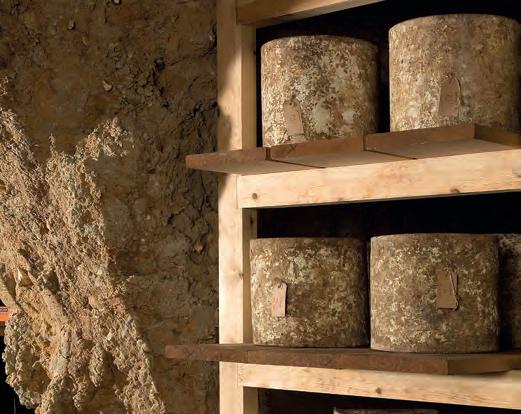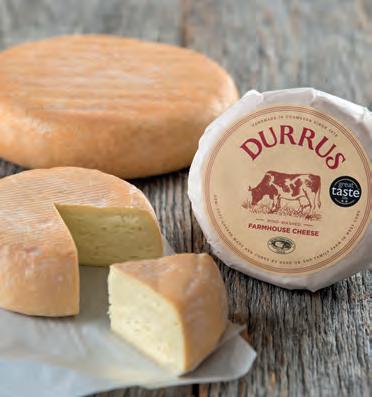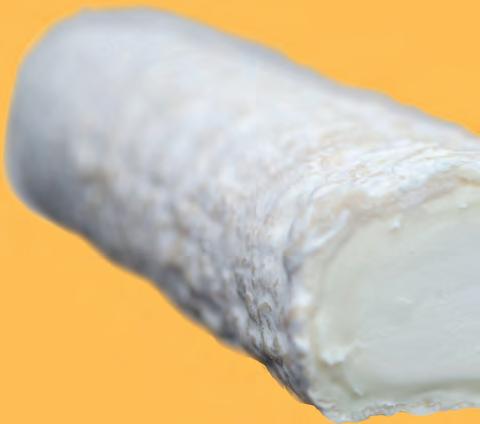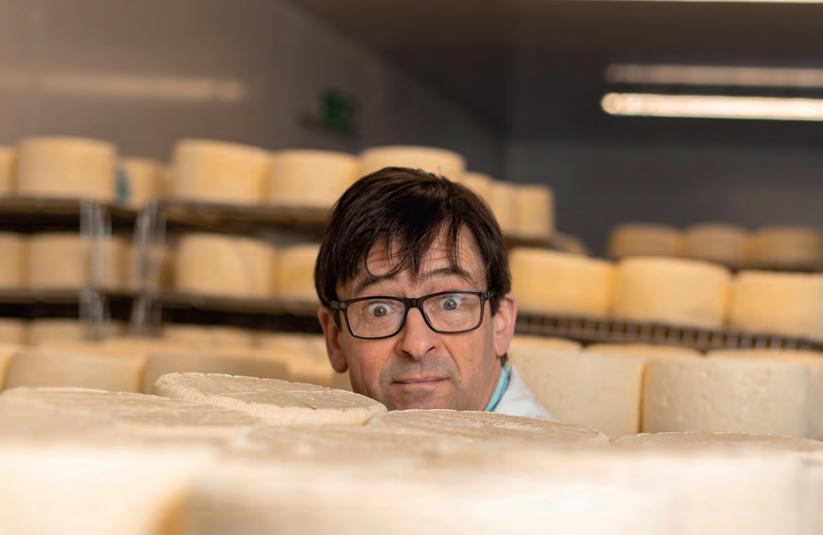
12 minute read
CHEESEWIRE
from FFD May 2021
Makers facing up to shortages and surpluses of hard cheeses
By Patrick McGuigan
Disruption to hard cheese production when the coronavirus pandemic hit last year is only being felt now as cheeses reach maturity – with some producers running short of stock and others facing a surplus.
So cheesemakers were immediately thrown into crisis during the rst lockdown because of the short shelf lives of their products, but there has been a delayed impact for producers of aged cheeses, who are only now feeling the e ects of decisions taken a year ago.
Holden Farm Dairy in Wales stopped production of its Hafod cheddar in April and May last year when restaurants closed, but consequently has no cheese to sell now, just as it reopens.
“Here we are a year later in a ‘hungry gap’ with no cheese available as we wait for summer 2020 cheese to mature,” said the company on Instagram. “Our Hafod customers have shown positivity and resilience, and now we are also grateful for their patience and understanding.”
At Isle of Mull Cheddar, coowner Brendan Reade is facing the opposite problem. “We’re bulging at the seams in the cheese store,” he said. “There’s nowhere else for the milk to go on Mull, so it has gone into cheese.
“No-one was furloughed. We continued milking cows and making cheese even when orders have dropped signi cantly during lockdowns.
“Consequently, the age pro le of our cheese is more like 18 months rather than 12 months. Cash ow has slowed down during this period. At a time when we had committed to major investment, we are starting to feel the pinch.
“Having cheese maturing in the cellar for longer is a strain, but the upside is that it is tasting great. With the lockdown being eased, we’re hopeful sales will pick up.”
Kent-based Winterdale Cheesemakers was forced to pour away 5,000 litres of milk during the rst lockdown and signi cantly cut production of its raw milk cheddar, which owner Robin Betts said could lead to shortages.
“Lockdowns have made planning di cult when you are making a cheese that won’t be ready for a year. It’s really opened our eyes that we need more exibility in the business”
To this end, the company has invested in a pasteuriser and bottling line to sell bottled milk, cream and butter under the new Kent Downs Dairy brand.
Some companies, like Kent’s Winterdale chose to reduce hard cheese production last year and now have less available to sell
NEWS IN BRIEF
Devon cheddar-maker Quicke’s has launched a new flavour map for people to fully appreciate cheese. The Flavour Mapping Project has been undertaken to chart the full tasting journey, from initial taste to mid-taste to aftertaste, providing a simple tool for cheese lovers to record their eating experience.
A new monthly cheese market will launch in West London in May. The first Chiswick Cheese Market will be on 16th May at The Old Market Place, with more than 20 cheesemakers and mongers taking stalls.
A new waxed cloth wrapping for food is targeting cheesemongers with larger sizes that can be used behind the counter as a replacement for clingfilm. WaxWrap, which is made from organic cotton cloth coated in a mixture of beeswax, pine resin and jojoba oil, is available in rolls up to 2m in length.
The Cheese Barge, a floating restaurant dedicated to cheese, opens this month in the Paddington Basin. The brainchild of Mathew Carver, who founded cheese conveyor belt restaurant Pick & Cheese, the double-decker barge will serve seasonal dishes that champion British cheeses, such as St Andrews Cheddar with green kimchi, curried Quicke’s Cheddar curds, and half a kilo of baked Baron Bigod. thecheesebar.com


THREE WAYS WITH...
Durrus
Produced in West Cork by Irish cheese pioneer Jeffa Gill and her daughter Sarah Hennessy, Durrus is a soft, elastic washed-rind cheese made from pasteurised cows’ milk. Aged for 6-10 weeks, the cheese has a pretty pink exterior with aromas of soil and hay, while the bulging paste is sweet and milky, with meaty flavours from the rind in more mature cheeses
Whiskey Clonakilty Double Oak is a blended whiskey made by the Clonakilty Distillery in Cork, which is aged in bourbon casks and finished in American oak. It’s clean and fresh with lovely grassy and apple aromas, plus spicy milk chocolate notes on the palate. These creamier, vanilla flavours dovetail with the buttery cheese, which also has a subtle cocoa note from the rind.
Pickles Durrus is a rich, earthy cheese with a yielding texture, particularly when it has been aged and broken down. It calls for an accompaniment with acidity and crunch, such as cornichons and pickled silverskin onions. Try Bread & Butter Pickles from Crooked Pickle Co – pickled cucumber and onions with added spices, which won two stars at last year’s Greate Taste Awards. Their bite and crunch send a bolt of energy through the cheese.
Raclette Durrus’s elastic texture makes it an absolute dream to melt. Belfast cheese shop Indie Füde recommends using it to make higher-level cheese on toast or for melting over potatoes in an Irish take on raclette. The rind becomes more fragrant and meaty in flavour when it’s heated, while the paste blisters and caramelises under the grill, making it even sweeter.
Cyprus gains PDO for Halloumi but producers are in a quandary
By Patrick McGuigan

Halloumi nally secured Protected Designation of Origin (PDO) status last month a er years of lobbying by the Cypriot government, but the news was greeted with dismay by producers who say it will severely limit the amount of cheese they can make.
Cypriot president Nicos Anastasiades hailed the decision by the European Commission to award PDO status to the cheese as “a milestone day for halloumi and our country”.
But dairy groups claimed the country had shot itself in the foot with the new regulations, arguing there was not enough milk produced on the island to meet the speci cation that halloumi must be made with at least 51% goat and sheep’s milk.
The Pan Cyprian Organisation of Cattle Breeders said there was a shortage of milk from goats and sheep, while huge quantities of the cows’ milk that was used in the past will now go unused. It also raised concerns that low-fat and avoured halloumi are not covered by the PDO, which means they could be made outside Cyprus.
The Cyprus Dairy Producers Association estimated that the shortage of goat and sheep’s milk could mean halloumi sales fall from €300m a year to €90m.
“These losses will lead to the destruction of the entire dairy industry, livestock and agriculture at a huge cost to the local economy,” it said in a statement.
Around 40% of Cyprus’ halloumi production is exported to the UK.
Following Brexit, the new PDO is not recognised under UK law and Cyprus would have to apply for protection under the new UK Geographical Indication scheme. However, the cheese is still protected by a trademark, which speci es it must be made in Cyprus.
Hmioannou
The PDO secured for Halloumi gives the cheese added protection against imitators but the new rules might also hamstring legitimate producers
BEHIND THE COUNTER TIPS OF THE TRADE
Moz Murphy, Grate, Newcastle
Grate in Newcastle proves that fitting out a cheese shop doesn’t have to follow a strict design plan. Chipboard walls and reclaimed furniture combine to create an eye-catching space, but owner Moz Murphy says this was created as much by budget constraints as it was by bold interior design vision.
“The builder put up chipboard when we first got in, while we worked out what we wanted to do, but a friend said it looked like grated cheese so we stuck with it,” she says. “I like its texture and that you can easily screw things into it, plus it gives the shop a warm inviting glow at night.”
A reclaimed Belfast sink held up by bedposts found in a skip and a desk made from reclaimed wood offcuts add to the character, while Murphy re-uses packaging to good effect. Wooden boxes for soft cheese are re-purposed as merchandising units and Baron Bigod boxes were turned into decorative lights at Christmas.
“People comment on the look of the shop all the time,” she says. “It’s not slick, so people find it welcoming.”
gratenewcastle.co.uk
CHEESE IN PROFILE with

Ragstone
What’s the story?
Ragstone is a matured goats cheese log, hand-made by Charlie Westhead and his small team at Neal’s Yard Creamery. The creamery was set up in 1996 when Charlie (who had previously worked as a cheesemonger at Neal’s Yard Dairy before moving into cheesemaking) moved to Dorstone in rural Herefordshire. Production is powered by electricity generated by the company’s windmill and
Appearance & texture: Appearance & texture:
The cheese has a creamyThe cheese has a creamywhite rind, pure white white rind, pure white interior and the texture interior and the texture is dense, smooth and is dense, smooth and fudgey – getting fudgey – getting more liquid as more liquid as it matures. It it matures. It has savoury, mushroom flavours with lactic lemon photovoltaic photovoltaic notes. solar panels. Heat solar panels. Heat requirements are also requirements are also met from hot water solar met from hot water solar Variations: panels and a customised panels and a customised There are There are furnace burning locally two sizes available: the sourced wood. popular 200g log and the larger 600g cutting How is it made? cheese. The goat’s milk for Ragstone is supplied by neighbours Andrew and Diane Goodwin and their small flock of 50/50 Toggenburg/ Saanan goats. The milk is pasteurised and cheesemaking begins with the addition of traditional kid rennet. Once the curds are formed, they are handladled into tube-shaped moulds. It is a slow, gentle process ensuring smooth and complex cheeses. The bloomy-white rind forms as the cheeses mature, for 2-4 weeks.
Cheesemonger tip:
The individual 200g logs are perfect for the multi-deck as well as the serveover counter. Merchandise it alongside sticky fig relish, damson jam or blossom honey. Recommend serving it with a Herefordshire perry.
Chef’s recommendation:
Select the young cheeses that have a dense and fudge-like texture. These will be ideal for slicing, and you can envelop it in puff pastry with a sprig of fresh thyme before baking for delicious warm goat’s cheese tarts. Serve with a chilled Sancerre.
While traditional classroom courses are suspended due to the COVID-19, delegates can still sign up to Academy of Cheese Level 1 & 2 courses online as self-study eLearning, or interactive virtual classroom courses. academyofcheese.org

Breaking the mould

Highland Fine Cheeses has enjoyed success with a range of powerful and sometimes controversial cheeses
By Patrick McGuigan
WHEN RORY STONE joined the family business in 1994, the traditional Scottish cheese Caboc accounted for around 95% of sales. Made by fermenting double cream for up to six months, before it is drained and formed into oat-rolled logs, legend has it that Caboc was first made on the Isle of Skye in the 15th century by a chieftain’s daughter who was an ancestor of Stone’s mother.
It’s a romantic tale, but it has done little to aid the cheese’s fortunes. Highland Fine Cheeses, based in Tain, Ross-shire, is the last remaining producer of Caboc in the world, but the cheese only accounts for 5% of sales today, with shoppers understandably wary of its bracing 75% fat content.
“I always feel with Caboc that one decent cold snap could write off 99% of the customer base,” jokes Stone. “They’ve eaten that much of it that they’ve already had triple heart bypasses.”
As Caboc has declined, it has been usurped by newer cheeses that owe more to European cheesemakers than the daughters of Scottish chieftains. Strathdon Blue, a soft, creamy cows’ milk blue, is the company’s best-seller, closely followed by other Continental-style cheeses, such as Blue Murder and Morangie Brie. “We’ve got a mouldy old dairy, so I thought we should focus on mouldy cheeses,” says Stone.
“My heart is with washed rinds, moulds, and oozy, gooey, flavours. That’s where I love to be on a cheeseboard.”
According to Stone, the British public is in the same place as him, preferring strongly flavoured Continental styles over traditional British cheeses. Highland Fine Cheeses saw a big surge in retail sales during the pandemic, which helped offset a drop in hospitality orders. Overall sales are down for the year, but not by much after a 15% increase at Christmas, he says.
“People are travelling and experiencing different tastes. There’s a reason that territorials are struggling; it’s because they don’t have a huge amount of flavour.
“New cheesemakers often want to use pint starters and unpasteurised milk and make traditional cheeses that used to be produced in their shire. But if the Model T Ford was perfect, we’d all still be driving it. I rail against the whole specialist cheesemaker thing. It’s at risk of becoming too evangelical and ethereal.”
This is a provocative statement in the tight-knit cheese world but is typical of Stone, who is not afraid to be contentious – a policy that sometimes lands him in trouble. When the company launched two washed-rind cheeses three years ago, their names were certainly controversial, if not outright offensive. Minger, inspired by Epoisses, and the semi-hard Fat Cow caused something of a scandal with some retailers refusing to stock them because of their names – a story that ended up being reported in The Times.
Stone says that he wasn’t trying to be offensive. “I wanted to de-Scotify the brand and take all the ‘bens’, ‘glens’ and ‘straths’ out of it. ‘Minger’ is Scottish slang for a smelly little thing, and it’s a smelly little orange cheese. And Fat Cow was originally going to be Holy Cow because it had holes in, but someone had registered the name. There was no real sense behind that one.”
Stone admits with a chuckle that they were “appalling name choices”, but he doesn’t seem too unhappy about all the publicity. “My sense is people will get over it and like the cheeses, so keep buying them,” he says. “My humour is sometimes mildly offensive. I’ve always been trying to do things slightly differently.”
hf-cheeses.com
CROSS SECTION
Strathdon Blue
1
Strathdon Blue was originally produced by the Milk Marketing Board in Aberdeen, but the recipe and equipment for the cheese were bought by Highland Fine Cheeses in the 1980s when Milk Marketing Board sites were sold off.
The cheese is made with pasteurised cows’ milk, which comes from three farms: Sibster, near Wick; Thrumster, which has a herd of organic Jersey cows; and Rootfield on the Black Isle which is converting to Ayrshire cows. The milk is set with vegetarian rennet and the curd cut into 1cm pieces, but it is not scalded. After moulding, the cheeses are dry salted and aged for around 10 weeks. There’s an even spread of blue veins and pockets in the soft paste, while the flavour is sweet, spicy and minerally.

2






